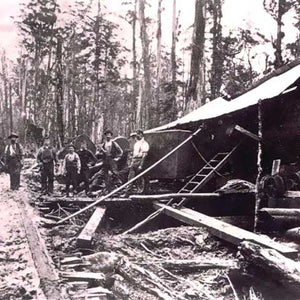History of the timber industry in Tasmania
The first convicts to arrive in Van Diemen's Land, were worked like slaves to provide timber needed for the fledgling settlements. Huon Pine was discovered shortly after settlement in 1803, large logs washed ashore on the lower Huon River and d'Entrecastreaux Channel. An expedition in 1815, by James Kelly, found Huon Pine growing along the banks of Macquarie Harbour, convicts and later freelance piners working the the Gordon River in the West the Huon River in the South and the Pieman River in the North - West of the state.
The Sarah Island penal settlement in Macquarie Harbour was completed in 1823, convicts working in chains and in terrible conditions provided Huon Pine logs for Hobart Town until 1833, when Sarah Island was closed and the convicts moved to Port Arthur. The first 150 convicts at Port Arthur worked in harsh conditions to establish a timber industry in the surrounding woodlands. Despite the harsh conditions at Port Arthur the timber industry grew into shipbuilding just as it had at Sarah Island. Many whaling vessels were built from Huon Pine.
As Hobart Town began to expand, the forest were cleared for agriculture and further settlement, with expansion of the settlement the local demand for timber also grew as did shipments to Britain, and the other colonies. Timber production expanded the deforestation increased with the introduction of steam in the 1850's.
The exploited Tasmanian forests were disappearing at an alarming rate, with very few signs of regenerating. The introduction of a State Forests Act, in 1885, provided an appointed Conservator of Forests, this position remained vacant between 1892 and 1918, until Llewellyn Irby was appointed. Irby was to develop a workable, use and management legislation for the Tasmania's forests. The legislation was passed in 1920, The legislation was the Forestry Act of 1920. The Forestry Department was established in 1921 and operated until 1946, when The Forestry Department then became The Forestry Commission.
Restructured in 1994, and renamed Forestry Tasmania, they continue to manage Tasmania's State (or public) Forests. Forestry Tasmania now manages 41 per cent of Tasmania's forests; 11 per cent of this area is in Forest Reserves, the remainder being available for timber harvesting. However, only about 50 per cent of State forest will ever be harvested.












